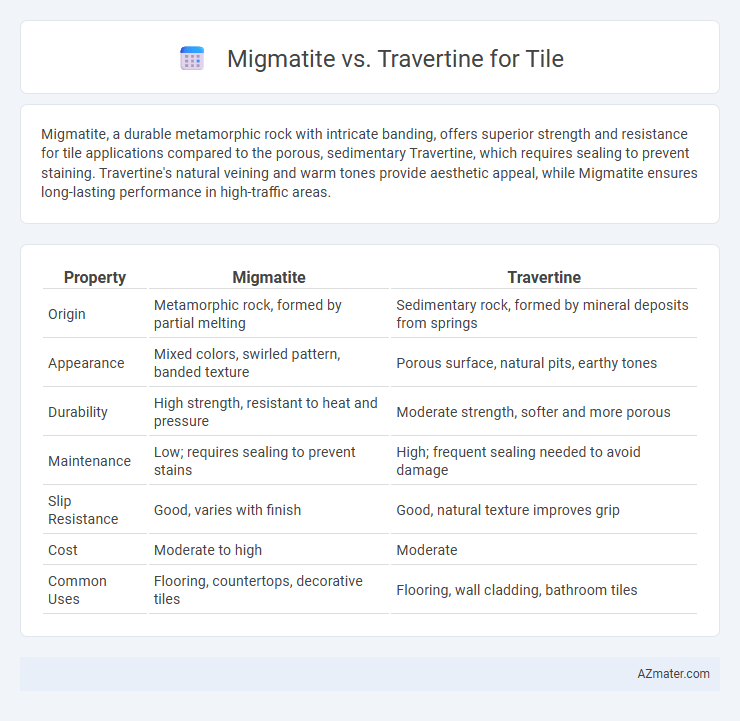Migmatite, a durable metamorphic rock with intricate banding, offers superior strength and resistance for tile applications compared to the porous, sedimentary Travertine, which requires sealing to prevent staining. Travertine's natural veining and warm tones provide aesthetic appeal, while Migmatite ensures long-lasting performance in high-traffic areas.
Table of Comparison
| Property | Migmatite | Travertine |
|---|---|---|
| Origin | Metamorphic rock, formed by partial melting | Sedimentary rock, formed by mineral deposits from springs |
| Appearance | Mixed colors, swirled pattern, banded texture | Porous surface, natural pits, earthy tones |
| Durability | High strength, resistant to heat and pressure | Moderate strength, softer and more porous |
| Maintenance | Low; requires sealing to prevent stains | High; frequent sealing needed to avoid damage |
| Slip Resistance | Good, varies with finish | Good, natural texture improves grip |
| Cost | Moderate to high | Moderate |
| Common Uses | Flooring, countertops, decorative tiles | Flooring, wall cladding, bathroom tiles |
Introduction to Migmatite and Travertine Tiles
Migmatite tiles are formed from metamorphic rocks that exhibit a unique blend of igneous and sedimentary characteristics, offering natural patterns with high durability and resistance to heat and scratches. Travertine tiles, a type of sedimentary limestone, feature porous textures with warm earth tones, commonly used for elegant flooring and wall applications due to their natural beauty and antiqued finish. Both tile types provide distinct aesthetic appeal and performance qualities suited for various interior and exterior design projects.
Geological Origins: Migmatite vs Travertine
Migmatite forms through the partial melting and recrystallization of metamorphic rocks under high-temperature and pressure conditions, resulting in a unique blend of igneous and metamorphic characteristics. Travertine is a sedimentary rock created by the rapid precipitation of calcium carbonate from mineral-rich hot springs or groundwater, often featuring porous textures and natural cavities. Understanding these distinct geological origins highlights migmatite's durability and variegated appearance compared to travertine's softer, porous nature and classic earth-toned patterns.
Appearance and Texture Differences
Migmatite exhibits a unique, swirling pattern due to its mixed metamorphic and igneous origin, featuring bands of light and dark minerals that create a marbled, complex look, while travertine presents a more uniform and porous surface with characteristic small pits and voids formed from mineral deposits in hot springs. Migmatite's texture is generally dense and smooth, providing a polished, glossy finish ideal for sophisticated tile applications, whereas travertine offers a naturally textured, matte feel that adds warmth and rustic charm to tiled spaces. The visual contrast between migmatite's intricate veining and travertine's soft, earthy tones allows each stone to cater to distinct aesthetic preferences in interior design.
Durability and Hardness Comparison
Migmatite exhibits superior durability and hardness compared to travertine, making it more resistant to scratches, heat, and heavy foot traffic in tile applications. Travertine, a softer carbonate stone, is prone to erosion, staining, and surface wear, requiring more frequent sealing and maintenance. The Mohs hardness scale rates migmatite generally around 6-7, while travertine scores between 3-4, underscoring the enhanced resilience of migmatite for long-lasting tile installations.
Slip Resistance and Surface Finishes
Migmatite offers superior slip resistance compared to Travertine due to its coarse-grained texture and natural mineral composition, making it ideal for high-traffic or wet areas. Travertine, characterized by its smooth, porous surface with natural pits and voids, typically requires sealing and surface finishing treatments to enhance slip resistance and durability. Surface finishes for Migmatite often include honing or rough polishing to maintain traction, whereas Travertine is frequently polished or honed to achieve an elegant look, impacting its slip resistance properties.
Installation Requirements for Each Stone
Migmatite tiles require precise cutting and sealing due to their complex mineral composition and layered structure, often necessitating professional installation to prevent chipping and ensure durability. Travertine, being a porous sedimentary stone, demands thorough sealing before and after installation to avoid staining and moisture penetration; its softer texture allows for easier cutting but requires careful handling to maintain surface integrity. Both stones benefit from a reputable adhesive suited for natural stone, with migmatite needing stronger bonding agents to accommodate its density compared to the more absorbent travertine.
Maintenance and Cleaning Considerations
Migmatite tiles demand regular sealing to prevent staining due to their natural porosity, with cleaning requiring pH-neutral cleaners to avoid surface damage. Travertine tiles also need consistent sealing because of their highly porous nature, and grout lines must be cleaned frequently to prevent buildup in the stone's natural cavities. Both materials benefit from gentle cleaning routines to maintain durability and aesthetic appeal over time.
Cost Analysis: Migmatite vs Travertine
Migmatite tiles generally cost more due to their rarity and complex formation involving both metamorphic and igneous processes, which increase quarrying and processing expenses. Travertine tiles are typically more affordable as they are sedimentary stones formed through mineral deposits in hot springs, allowing for easier extraction and widespread availability. Maintenance and durability costs also favor Migmatite, as its hardness reduces the need for frequent repairs compared to the softer, more porous Travertine.
Best Applications for Each Tile Type
Migmatite tiles excel in high-traffic areas and outdoor spaces due to their exceptional durability, resistance to scratching, and natural stone appearance, making them ideal for kitchens, hallways, and patios. Travertine tiles, characterized by their porous texture and earthy tones, are best suited for bathrooms, backsplashes, and indoor flooring where moisture regulation and aesthetic warmth are important. Selecting Migmatite ensures long-term resilience and low maintenance, while Travertine offers a unique, rustic charm and natural slip resistance in more controlled environments.
Environmental Impact and Sustainability
Migmatite, a natural metamorphic rock, offers significant durability and low environmental impact due to its abundant availability and minimal processing requirements, making it a more sustainable choice for tile production. Travertine, a form of sedimentary limestone, requires extensive quarrying and chemical treatments, resulting in higher carbon emissions and environmental disturbances compared to migmatite. Choosing migmatite for tiles supports sustainability through reduced resource extraction and longer lifespan, minimizing ecological footprints over time.

Infographic: Migmatite vs Travertine for Tile
 azmater.com
azmater.com